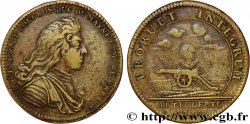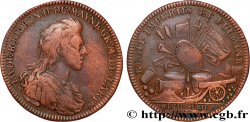fjt_011856 - ARTILLERY Louis-Charles de Bourbon, comte d’Eu 1754
Not available.
Item sold on our e-shop (2014)
Price : 90.00 €
Item sold on our e-shop (2014)
Price : 90.00 €
Type : Louis-Charles de Bourbon, comte d’Eu
Date: 1754
Metal : red copper
Diameter : 28 mm
Orientation dies : 6 h.
Edge : lisse
Rarity : R1
Coments on the condition:
Aucune raison de penser qu’il s’agisse d’une refrappe
Obverse
Obverse legend : LOUIS CH DE BOURBON D D EU DUC D AUM G M DE L ART.
Obverse description : Buste de Louis-Charles de Bourbon, comte d’Eu.
Reverse
Reverse legend : TACTU EMICAT INTONAT ARDEM ; À L'EXERGUE : ARTILLERIE 1754.
Reverse description : Franklin (?) faisant des expériences sur les effets lumineux et calorifiques de l'électricité.
Reverse translation : En le manipulant, il brille, et il fait gronder avec fracas des flammes.
Commentary
Louis-Charles de Bourbon, comte d’Eu, est le second fils de Louis-Auguste de Bourbon, duc du Maine et fils légitimé de Louis XIV et de Madame de Montespan. Très aimé de son père, le duc du Maine reçut rang immédiatement après les princes du sang et fut nommé grand maître de l’artillerie. Il obtint aussi les principautés d’Aumale et de Dombes. Louis-Charles, déjà comte d’Eu, reçut l’héritage de son frère aîné, Louis-Auguste, tué en duel en 1755
Anne-Marie-Louis d'Orléans, connue sous le nom de la "Grande Mademoiselle"mourut en 1693, laissant la principauté de Dombes à Louis Auguste de Bourbon, duc du Maine, fils de Louis XIV légitimé en 1673. Louis Charles de Bourbon, comte d'Eu, échangea le 28 mars 1762 la principauté de Dombes contre le duché de Gisors.
Anne-Marie-Louis d'Orléans, connue sous le nom de la "Grande Mademoiselle"mourut en 1693, laissant la principauté de Dombes à Louis Auguste de Bourbon, duc du Maine, fils de Louis XIV légitimé en 1673. Louis Charles de Bourbon, comte d'Eu, échangea le 28 mars 1762 la principauté de Dombes contre le duché de Gisors.








 Report a mistake
Report a mistake Print the page
Print the page Share my selection
Share my selection Ask a question
Ask a question Consign / sell
Consign / sell
 Full data
Full data



